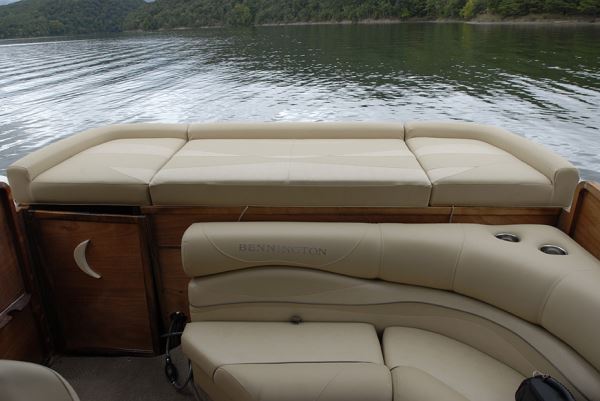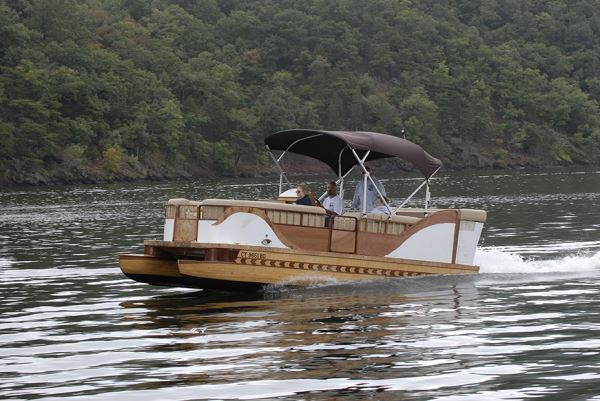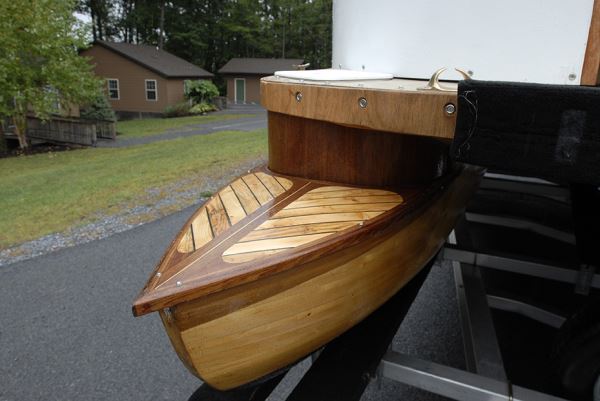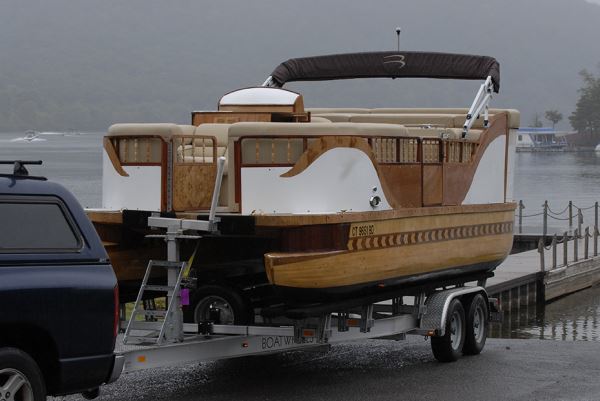It may have taken over a dozen years to complete, but Dan Williams is not complaining. It's true that a good portion of his free time has been spent meticulously going over the fine details while constructing the ultimate pontoon, but this project has been more than just a labor of love. So why did it take so long to build? Well, for starters, the all-wood pontoon was handcrafted in his basement in Connecticut.
"It took a long time to complete, but at least I knew where he was all the time," says his wife Denise. "He was always thinking, drawing, working and talking about it, sometimes too much. There was never any room to walk around in his shop, because the boat was always in the way."
The one-of-a-kind wooden pontoon was officially splashed last summer and the three-log, 22 1/2- foot beauty has been turning heads ever since. Dan was good about documenting his progress with photos along the way, but those who have been fortunate enough to see the boat in person understand that pictures simply don't do the boat justice. It's almost impossible to imagine the hours that went into designing and executing the wooden pontoon that he named All Spruced Up. But Dan does have a good idea on other figures that he kept track of along the way.
foot beauty has been turning heads ever since. Dan was good about documenting his progress with photos along the way, but those who have been fortunate enough to see the boat in person understand that pictures simply don't do the boat justice. It's almost impossible to imagine the hours that went into designing and executing the wooden pontoon that he named All Spruced Up. But Dan does have a good idea on other figures that he kept track of along the way.
Based on his best estimate, the talented artist figures he used 8000 individual pieces of hand-fitted wood, 32 gallons of epoxy used for gluing and sealing and roughly 17 to 20 different types of wood.
"I think a better term for this endeavor might be crazy," admitted Dan a few years ago when his project started getting some attention on the PDB Forum. "Hopefully, she'll turn out as pretty as I have dreamed."
Starting With A Vision
 To get started, every design was done with paper and pencil and then converted to a one-tenth scale model that he built for visualization. During his design process he studied many commercial boats and gathered the better ideas from these to incorporate into his boat, yet he stayed flexible along the way.
To get started, every design was done with paper and pencil and then converted to a one-tenth scale model that he built for visualization. During his design process he studied many commercial boats and gathered the better ideas from these to incorporate into his boat, yet he stayed flexible along the way.
"Originally I was going to only have two hulls, but I added a center tube for extra flotation and storage," says the craftsman. "And portions of the design changed during construction. I was going to construct wood framed furniture, but my son convinced me to just buy it in order to save time."
The furniture is from Bennington's anniversary edition R-series that can be found on its 2050 RL models. And with the help of his local Bennington dealer, Dan was able to purchase the anniversary fabrics by the yard, so his sundeck would match his seats.
Building The Toons
The outboard hulls were strip planked in a fashion similar to a canoe or kayak and Dan estimates  there are approximately 300 strips in each one. To reinforce the bottom and the center hull he learned to cold-mold, which is a technique where layers of thin wood strips (1/8-inch by 3-inch) are laid over a frame at 45 degree angles and edge-glued. A second layer is epoxied at 45 degrees in the opposite direction. The result is similar to plywood except for the bends and curves. Dan chose this method so his hull would be strong, but with minimum weight gain.
there are approximately 300 strips in each one. To reinforce the bottom and the center hull he learned to cold-mold, which is a technique where layers of thin wood strips (1/8-inch by 3-inch) are laid over a frame at 45 degree angles and edge-glued. A second layer is epoxied at 45 degrees in the opposite direction. The result is similar to plywood except for the bends and curves. Dan chose this method so his hull would be strong, but with minimum weight gain.
The craftsman also used the cold-molding method when he built complex-curved components like the aft belly skins, sundeck supports, gauge hood, etc. "I never had enough clamps, even with over 150 of them," says Dan.
The outer hulls have full bulkheads every two feet, while the inner hull only has three full bulkheads along with some open frames in it. All three hulls have their bow sections filled with poured-in flotation foam.
End In Sight?
As the dream of building a wooden pontoon progressed along the way, at times his wife didn't seem to share his optimism. "I wasn't sure if it would ever be completed," admits Denise. "He has started many projects, some of which are still waiting to be finished and this one was huge."
But Dan remained focused and determined to finish his project as he continued to battle challenges such as getting the hulls out of the basement after they had been built, as well as the added cost near the end to complete the project.
Wood Selection
 "I always like to use contrasting wood colors because there are so many different colors that occur naturally in wood," says Dan. "I found most of my wood in local specialty woodworking stores. I was very `cheap' with my scraps for many of the varieties and when the scraps were difficult to pick up off the workbench then I knew it was okay to throw them out."
"I always like to use contrasting wood colors because there are so many different colors that occur naturally in wood," says Dan. "I found most of my wood in local specialty woodworking stores. I was very `cheap' with my scraps for many of the varieties and when the scraps were difficult to pick up off the workbench then I knew it was okay to throw them out."
For the dash panels Dan had something special in mind. The wood he decided to go with was Curly Maple that he got from his grandfather's tree in Washington state.
"My dad has made clocks for four generations of our family from that same tree," says Dan. "I was fortunate there was still some left in my dad's attic for my boat."
A Boat On A Diet
Weight was a key factor that Dan kept in mind during the entire process from designing to the actual construction. Along the way he attempted to use the lightest woods and best construction techniques that were available to keep the total weight as low as possible. .
"I will go through an entire bin while selecting wood, often looking for the lightest pieces," says the Connecticut native. "I estimated originally that she'd be around 2500 to 2800 pounds and it ended up being about 2900."
When planning for the outboard, Dan built a beefy 2 and 1/2-inch thick transom in anticipation of increasing the horsepower in the future, even though he had already decided to go with a remanufactured Evinrude 90hp.
The final step after the boat had its launch date set was to apply a good grade of Marine Spar varnish over the epoxy to ward off the UV rays. And on Labor Day 2009 All Spruced Upwas launched while family and friends cheered.
"It was a great feeling to finally launch her," says Dan. "I still have work to do, but at a slower pace now."
Adds Denise, "The boat is very beautiful and it's truly a one-of-a-kind pontoon. Owning a boat has never really been my dream, as I prefer water where I can touch bottom. But Dan has been able to build his dream boat and now we actually have one sitting in the driveway waiting for us to use."
The beautiful pontoon will continue to be a work in progress as Dan puts his finishing touches to it along the way. But the important part is that the boat is now on the water being used and no longer taking up room in the basement. Sounds like it might be time for Dan to start his next project.

